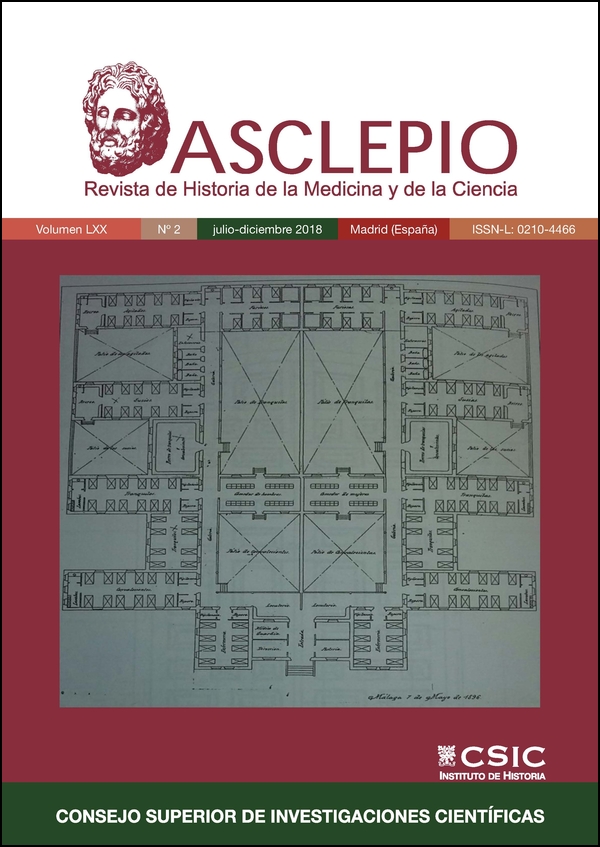Crossing paths for psychologizing of trauma in medical knowledge by the end of the nineteenth century
DOI:
https://doi.org/10.3989/asclepio.2018.21Keywords:
trauma, psychologization, railway, hysteria, conceptual frameworksAbstract
In this article, we will try to investigate three different ways which contributed to the process of “psychologizing” of trauma. First, Erichsen’s work (1866), a surgeon who explained certain cases of railway accident victims (which were located in a great field between the provable injury and simulation) with the framework of the pathological anatomy. Second, the physiological perspective of Page (1883), who tried to interpret that dubious territory of the clinic as a result of a Nervous Shock produced by an emotion that can alter the function without damaging the tissue. Finally, the lessons of Charcot in 1885, dedicated to traumatic hysteria, became plausible the idea that emotions and ideas could be traumatic by themselves, idea that was modeled on the action of hypnosis and suggestion in the nervous system. Throughout the text, we will try to justify that the transformations of the notion of trauma (and what each author could observe and think) depend on conceptual frameworks from which clinical experience was discussed.
Downloads
References
Barona, José Luis (1991.) La fisiología: Origen histórico de una ciencia experimental, Madrid, Akal.
Caplan, Eric (2001). "Trains and Trauma in the American Gilded Age". En: Micale, Mark y Lerner, Paul (eds.), Traumatic Pasts. History, Psychiatry, and Trauma in the Modern Age, 1870-1930, Cambridge, Cambridge University Press, pp. 57-80. https://doi.org/10.1017/CBO9780511529252.004
Charcot, Jean Marie (1887), Leçons sur les maladies du système nerveux faites a la Salpêtrière, Tome III, Paris, Bureaux du Progrès Médical.
Danziger, Kurt (2010), "Historical roots of the psychological laboratory". En: Constructing the Subject. Historical Origins of Psychological Research, Cambridge, Cambridge University Press.
Erichsen, John Eric (1866), On railway and other injuries of the nervous system, Philadelphia, Henry C. Lea.
Foucault, Michel (1963), El nacimiento de la clínica, México D.F., Siglo XXI.
Freud, Sigmund (1893/1986), "Algunas consideraciones con miras a un estudio comparativo de las parálisis motrices orgánicas e histéricas". En: Freud, Sigmund (1986), Obras completas, Tomo I, Buenos Aires, Amorrortu, pp. 191-210.
Furneaux Jordan, Thomas (1873), Surgical Inquiries, Nabu Press.
Gauchet, Michel y Swain, Gladys (2000), El verdadero Charcot, Buenos Aires, Nueva Visión.
Gros Clark, Frederik le (1870), Lectures on the Principles of Surgical Diagnosis: Especially in relation to shock and visceral lesions, London, John Churchill and Sons.
Hacking, Ian (1995), Rewriting the Soul: Multiple Personality and the Sciences of Memory, Princeton, Princeton University Press.
Harrington, Ralph (2001), "The Railway Accident: Trains, Trauma, and Technological Crisis in Nineteenth-Century Britain". En: Micale, Mark y Lerner, Paul (eds.), Traumatic Pasts. History, Psychiatry, and Trauma in the Modern Age, 1870-1930, Cambridge, Cambridge University Press, 31-56. https://doi.org/10.1017/CBO9780511529252.003
Leys, Ruth (2000), Trauma. A genealogy, Chicago, The University of Chicago Press.
Micale, Mark y Lerner, Paul (eds.), (2001), Traumatic Past: History, Psychiatry, and Trauma in the Modern Age, 1870- 1930, Cambridge, Cambridge University Press.
Micale, Mark (2001), "Jean-Martin Charcot and les névroses traumatiques: From Medicine to Culture in French Trauma Theory of the Late Nineteenth Century". En: Micale, Mark y Lerner, Paul (eds.), Traumatic Pasts. History, Psychiatry, and Trauma in the Modern Age, 1870-1930, Cambridge, Cambridge University Press, 115-139. https://doi.org/10.1017/CBO9780511529252.007
Oppenheim, Hermann (1900), Diseases of the nervous system, Philadelfia y Londres, J. B. Lippincott Company.
Page, Herbert (1883), Injuries of the Spine and Spinal Cord without Apparent Mechanical Lessions, and Nervous Shock, in their surgical and Medico-Legal aspects, Philadelphia, P. Blakiston, Son y Co.
Published
How to Cite
Issue
Section
License
Copyright (c) 2018 Consejo Superior de Investigaciones Científicas (CSIC)

This work is licensed under a Creative Commons Attribution 4.0 International License.
© CSIC. Manuscripts published in both the print and online versions of this journal are the property of the Consejo Superior de Investigaciones Científicas, and quoting this source is a requirement for any partial or full reproduction.
All contents of this electronic edition, except where otherwise noted, are distributed under a Creative Commons Attribution 4.0 International (CC BY 4.0) licence. You may read the basic information and the legal text of the licence. The indication of the CC BY 4.0 licence must be expressly stated in this way when necessary.
Self-archiving in repositories, personal webpages or similar, of any version other than the final version of the work produced by the publisher, is not allowed.















